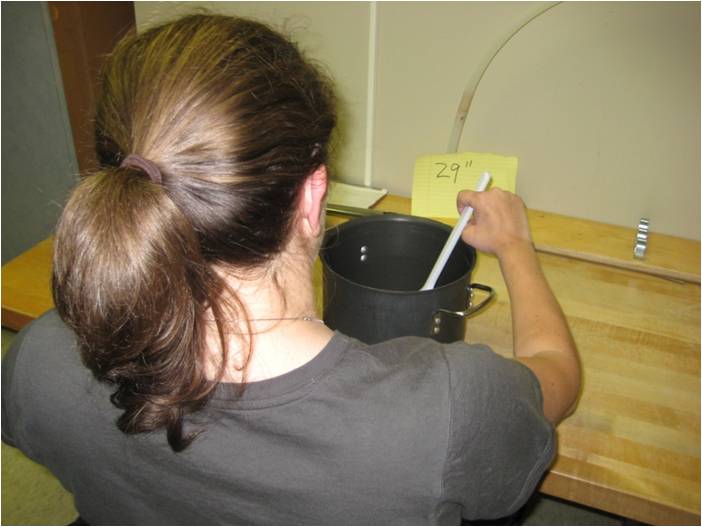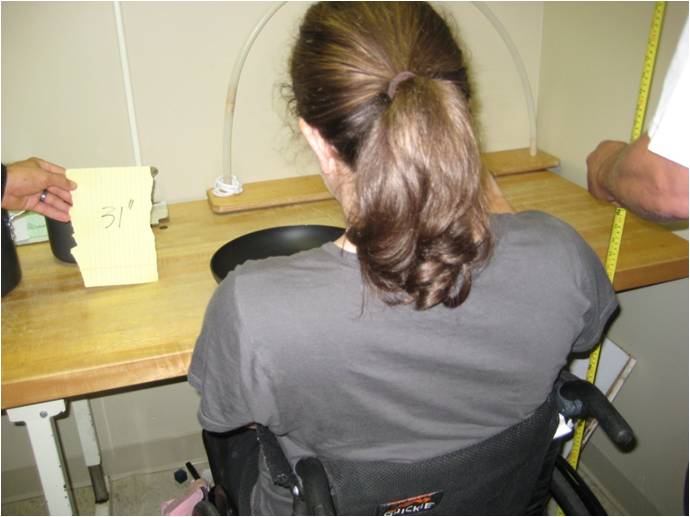Case Study: OT and Remodeler Partnership Leads to Client Satisfaction
By Susan Bachner, MA, OTR/L, FAOTA, SCEM, CAPS, CEAC
Creating supportive home environments in which residents and visitors can pursue activities of daily living with comfort, accessibility, safety and social participation is as important for clients who are aging in place as it is for those with a known medical condition.
The project is most successful when there is a partnership between the client, the remodeler and the occupational therapist (OT); each party brings a unique perspective to the project. A recent NAHB survey shows that almost 50% of CAPS remodelers have worked with occupational therapists on projects. It is critical that all members’ roles fit like pieces of a jigsaw puzzle.

The client tests a soup pot at a height of 29".

The client tests a skillet at a height of 31".
Although the project described in the coming paragraphs evolved from a catastrophic situation, the collaborative principles remain just as important when meeting the needs and wants of clients in the developmental stage called “aging.”
My client in this project was a 31-year-old newly married woman who sustained a C-6 incomplete spinal cord injury that resulted in quadriplegia. After stabilizing, she began extensive rehabilitation and around the same time made contact with me.

Kitchen sink and stove raised in the up position.

Kitchen sink and stove lowered in the down position.
The client's goal was to return home and be as independent as possible. Accessibility was the primary objective, but the aesthetic appearance was just as important to her. After spending months in rehabilitation centers and hospitals recovering from the accident, she didn’t want her home to take on an institutional appearance once the accessibility was improved.
The project team consisted of myself as the OT, and BACK Construction, a remodeling company with an in-house staff that does everything, from design to demolition to execution.
After the initial contact from the client and her rehabilitation team, I began an evaluation of her needs and wants, abilities, medical and social status, home environment and people in her system. I also used information from the findings of her therapists and physicians.
Her life roles consisted of being a wife, stepmother, friend, family member and patient. Her interests included cooking, gardening, socializing and horseback riding.
During the evaluation, she articulated that she wanted to be able to provide self-care and home management (e.g., laundry, cooking), access the outdoors and resume horseback riding. Enjoying social activities with her husband and friends was important to her as well.
I shared my OT report with the client, contractor, case managers, rehabilitation team and third-party payer. The report specified products and space considerations that would increase her independence and mobility in the home. My recommendations were based on medical necessity and were considered critical for the client to achieve functional goals.
The other half of the home modification team, BACK Construction, has many CAPS certified professionals on staff, with whom I had previously collaborated on various projects.
Rob Hundley, one of the principals, said that “the consumer needs to hear as much as the remodeler [does] that the project utilizing an occupational therapist’s expertise is a team sport!”
The BACK staff understood that in this particular user-specific project, a half-inch could make a huge difference in whether our client was able to function more independently. They were actively involved in creating the spaces based on the occupational therapy report, welcomed the incorporation of new assistive products into the remodeled spaces and executed the intent and goals of the project.
Clarification about the use of Americans with Disabilities Act (ADA) mandates is important. Application of the guidelines are often misunderstood and/or misapplied in the residential remodeling marketplace. All parties must recognize that ADA applies to public spaces (with a few exceptions), not to private homes, and that ADA guidelines are based on studied averages of body types and abilities not on a specific person. In private homes, the modifications should reflect both universal design (UD) principles as well as attention to user-specific features that exceed the scope of UD.
Using the services of an occupational therapist for a client with aging-in-place issues and/or known medical conditions allows for a personalized and holistic evaluation aimed at functional performance for the present and future.
Susan Bachner is an occupational therapist and accessibility/home modifications consultant. For additional information and photos of this project, please visit www.susanbachnerconsulting.com.
A special thank you to Sandy Cook, Sales Associate and Project Estimator at BACK Construction for her review and most helpful comments about this piece.
This story originally appreared in the Nov.19, 2013 edition of CAPS Connection.



